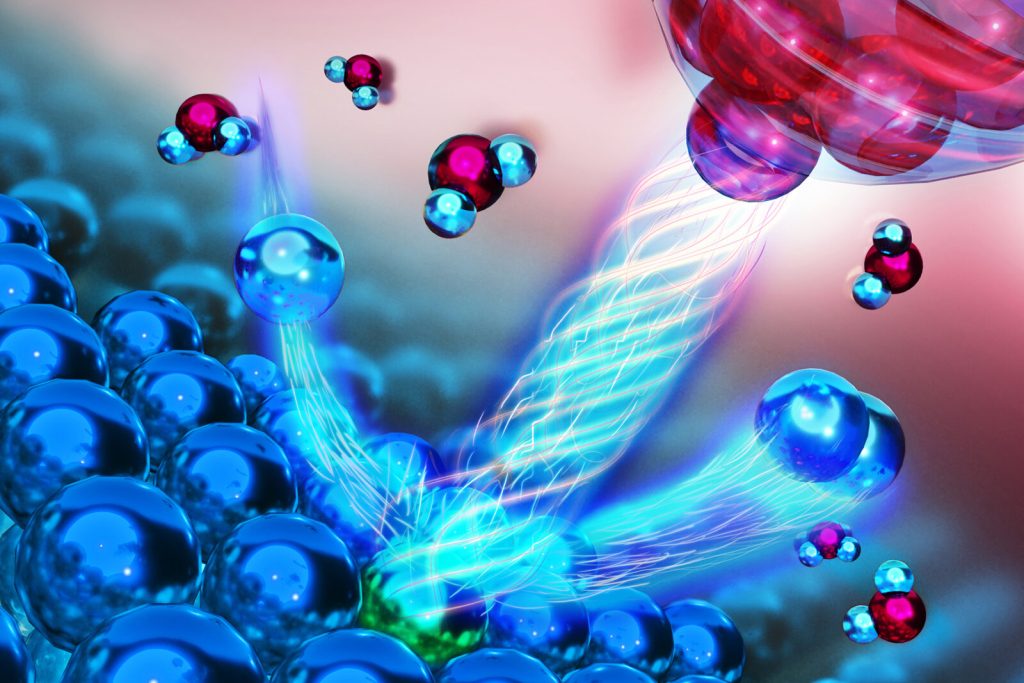
Innovative electrocatalysts for hydrogen production
Another success for the scientists from the Institute of Experimental Physics UWr! The University of Wrocław informs that after the publication in Nature Catalysis they publish their studies on electrocatalysts for hydrogen production on the pages of the prestige journal JOULE (IF: 41.248).
The development of a green, alternative hydrogen economy based on hydrogen production by the electrochemical process of water splitting is dependent on effective, stable, and economical electrocatalysts. Currently, the materials commonly applied in constructing catalysts are platinoids. Those elements show the best catalytic properties to date, however they are very scarce, which affects their high price. Additionally, mining new platinum and its recycling contribute significantly to CO2 emissions over the entire life cycle of electrolysers. Currently a few strategies are applied to decrease the demand or totally replace precious metals while maintaining or even increasing the performance of those devices. Platinum alloys, nanostructural catalysts (e.g. core-coating), metals outside the platinum group, carbides and halides of transition metals, or nitrides and phosphides are introduced. Developed innovative catalysts based on the above mentioned new materials are mainly optimised by the empirical method of “trial & error”, which considerably slows the development of green energy.
As JOULE reports, a group of researchers engaged in development of catalysts for hydrogen production reactions published another study using a new methodology first presented in Nature Catalysis. The cr-EC-STM method allows for a rational optimisation of catalytic materials. One of the authors of the study is dr Tomasz Kosmala from the Institute of Experimental Physics of the Department of Physics and Astronomy of the University of Wrocław, who in collaboration with a research group from the University in Padova, headed by prof. Stefano Agnoli, published studies titled Atom-by-atom identification of catalytic active sites in operando conditions by quantitative noise detection. This paper details a quantitative method based on noise analysis of quantum tunnel current recorded during image acquisition with atomic resolution using EC-STM. This method, going beyond the current state of knowledge, allows not only to provide new information on the atomic structure of catalytic sites, but above all to evaluate the catalytic activity of single atoms using proposed quantitative descriptors such as local overpotentials and local Tafel line gradients.
The experimental data presented in the newest publication show the great potential of the cr-EC-STM method which is the only technique that can be applied in the working conditions of the catalyst (in operando). It provides atomic-scale catalytic activity data unobtainable to date with classic methods. It is vitally important because the standard electrochemical measurements provide averaged information (the total catalytic current comes from the electrode under test) hence, it does not always allow to infer the activity of individual nanoscale structures on the catalyst surface. Considering the unique spatial resolution, the cr-EC-STM method allows to easily break down the complex chemical reaction of any system into individual components. Thanks to new measurement data a paradigm shift in the approach to electrocatalyst design will be possible – from identifying active sites at the atomic level, to evaluating their catalytic performance, to rational catalyst design through the use of a knowledge-based approach.

Finally, a few words about points
Success has more than one name, and its measure in our reality are ministerial points that do not always indicate the value of scientific achievements. It is astonishing that the impact factor (IF) of the journal JOULE (IF: 41.283) is higher than the number of points awarded by the ministry (40 pts.)! Similar carelessness has occurred after the recent publication in the prestigious journal Nature Catalysis (IF: 41.813), whose scientific value had been put at only 100 pts. (although it still has increased after the recent changes from 70 pts.) Such dissonance should be and is worth correcting, and this can be done by periodically automatically modifying the journal evaluation process to maintain consistency between the two evaluation systems.
The article Atom-by-atom identification of catalytic active sites in operando conditions by quantitative noise detection can be found on the JOULE journal website, as well as:
More information will be privided by dr Tomasz Kosmala from the Institute of Experimental Physics UWr (e-mail: tomasz.kosmala@uwr.edu.pl)
Added by: Joanna Molenda-Żakowicz
Dean’s representative for promotion and media relations
